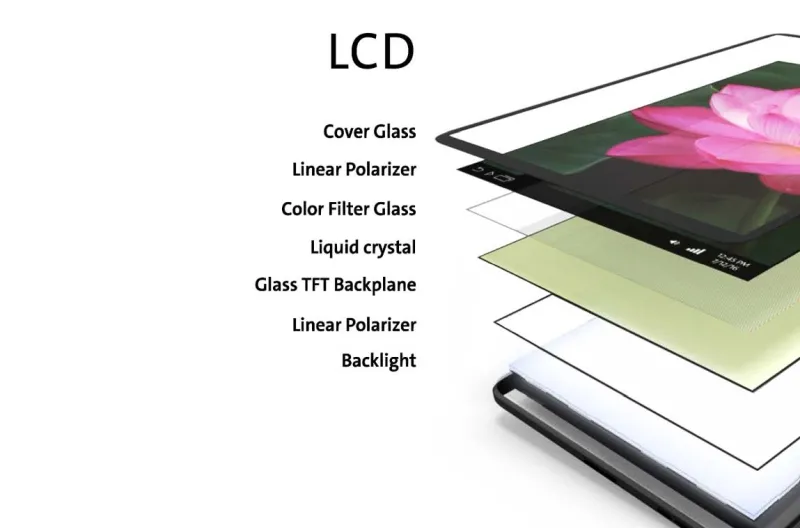(toc)
When buying a new smartphone or TV, choosing the right display type is very important. You’ve probably come across terms like LCD, OLED, AMOLED, and Super AMOLED. But what do these terms mean, and which is best for you? In this guide, we’ll break down each display type, explain their functions, and help you decide which one is best for gaming, personal use, and more.
1. What is an LCD Display?
LCD (Liquid Crystal Display) is one of the oldest and most common types of displays. It uses a backlight to illuminate the pixels, which means each pixel doesn’t emit light on its own. LCD displays are known for being affordable and widely used in budget devices.
Advantages of LCD:
- Affordable: Cheaper than OLED and AMOLED.
- Good for bright environments: Easy to see under direct sunlight.
- Durability: Less likely to suffer from screen burn-in.
Disadvantages of LCD:
- Lower contrast: Blacks appear more like dark grey.
- Lower power efficiency: Constant backlight means more power consumption.
Best for: Budget smartphones, TVs, and regular usage where cost matters.
2. What is OLED Display?
OLED (Organic Light-Emitting Diode) is a newer technology compared to LCD. Unlike LCD, each pixel in an OLED display emits its own light, which allows for deeper blacks and higher contrast.
Advantages of OLED:
- True blacks and high contrast: Each pixel can turn off, giving perfect blacks.
- Better color accuracy: Vibrant and accurate colors.
- Power-efficient in dark mode: Since individual pixels turn off, it uses less power.
Disadvantages of OLED:
- Expensive: OLED displays are usually pricier.
- Screen burn-in risk: Prolonged use of static images can cause burn-in.
Best for: High-end smartphones, TVs, and users who prefer deeper blacks and vibrant colors.
3. What is AMOLED Display?
AMOLED (Active Matrix Organic Light-Emitting Diode) is an advanced version of OLED. It includes a thin-film transistor (TFT) layer that allows for better pixel control. This means AMOLED displays are brighter and more energy-efficient than standard OLED displays.
Advantages of AMOLED:
- Better brightness and contrast: Great for outdoor use.
- More power-efficient than OLED: Better energy savings, especially in darker screens.
- Thin and flexible: Often used in smartphones with curved screens.
Disadvantages of AMOLED:
- Price: More expensive than LCD.
- Burn-in: Like OLED, it can suffer from burn-in over time.
Best for: Users who want vibrant colors, energy efficiency, and better outdoor performance.
4. What is Super AMOLED Display?
Super AMOLED is Samsung’s marketing term for an advanced version of AMOLED. It integrates the touch layer into the display, which reduces thickness and improves touch sensitivity. Super AMOLED offers the best of both worlds: better brightness, energy efficiency, and touch response.
Advantages of Super AMOLED:
- Thinner and lighter: Perfect for slim devices.
- Best brightness and contrast: Ideal for gaming and outdoor use.
- Improved touch sensitivity: Faster and more responsive touch controls.
Disadvantages of Super AMOLED:
- Price: Higher price than AMOLED and LCD.
- Potential burn-in: Like other OLED-based displays, Super AMOLED can also face burn-in issues over time.
Best for: Gamers, high-end smartphone users, and people who want the best visual experience.
5. Which Display is Best for Gamers?
For gaming, the display should have high brightness, vibrant colors, and fast response times. Super AMOLED and AMOLED are the top choices due to their excellent contrast, vivid colors, and touch sensitivity. Super AMOLED offers a smoother gaming experience with better brightness and touch response, making it the best for gaming.
Best choice for gamers: Super AMOLED > AMOLED > OLED > LCD
6. Which Display is Best for Personal Use?
For everyday personal use, it depends on your needs and budget:
- If you want affordability and durability, LCD is a solid option.
- If you value vibrant colors and deeper blacks, OLED and AMOLED are better.
- If you use your phone in bright outdoor settings and need best-in-class visuals, go for Super AMOLED.
Best choice for personal use:
- Budget users: LCD
- High-quality viewing: OLED or AMOLED
- Premium experience: Super AMOLED
7. Additional Tips for Buying a Device with the Right Display
- Check the refresh rate: Higher refresh rates like 90Hz or 120Hz give smoother scrolling and gaming experiences.
- Consider your usage: If you watch a lot of videos or game frequently, invest in an AMOLED or Super AMOLED display for the best visual quality.
- Battery consumption: OLED and AMOLED can save battery in dark modes, but LCD tends to use more power with bright backgrounds.
Which One Should You Buy?
Choosing between LCD, OLED, AMOLED, and Super AMOLED depends on your budget and how you use your device. For gamers, Super AMOLED is the clear winner due to its high brightness, contrast, and fast touch response. For personal use, if you want better colors and visuals, opt for OLED or AMOLED, but if you’re on a budget, LCD still gets the job done.
Before buying, always compare the price, features, and your needs to get the most value for your money.


.png)




